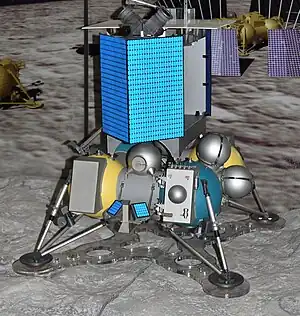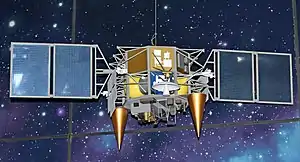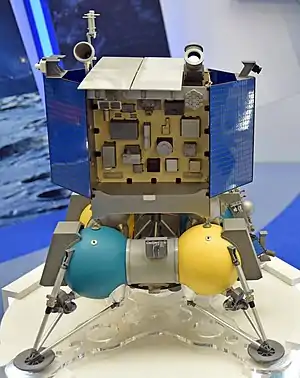International Lunar Research Station
The International Lunar Research Station (ILRS) (Chinese: 国际月球科研站) is a planned lunar base currently being led by Roscosmos and the China National Space Administration (CNSA). The ILRS will serve as a comprehensive scientific experiment base built on the lunar surface or in lunar orbit that can carry out multi-disciplinary and multi-objective scientific research activities including exploration and utilization, lunar-based observation, basic scientific experiment and technical verification, and long-term autonomous operation. Statements from Roscosmos and CNSA underline that the project will be "open to all interested countries and international partners."[3][4][5][6]
| Program overview | |
|---|---|
| Country | |
| Purpose | Crewed lunar exploration and research |
| Program history | |
| Duration | Reconnaissance: 2021–2025 Construction: 2026–2035 Utilization: from 2036 |
History
On 16 June 2021, Roscosmos and the China National Space Administration (CNSA) held a joint session in St. Petersburg on the auspices of the Global Space Exploration Conference (GLEX 2021), dedicated to the presentation of the Roadmap for the creation of the International Lunar Research Station (ILRS). The session was attended by Sergei Saveliev, the Deputy Director General of Roscosmos for International Cooperation and Wu Yanhua, the Vice Administrator of CNSA (remotely).
Roscosmos and CNSA representatives held consultations on a draft declaration in September 2021, together with experts from Germany, France, Italy, the Netherlands, Malaysia, Thailand and the UN Office for Outer Space Affairs. The talks took place behind closed doors.[7]
In June 2023, two more countries joined the International Lunar Research Station project, the United Arab Emirates and Pakistan, as well as the Asia-Pacific Space Cooperation Organization (APSCO). Malaysia may join in the future.
In July 2023, China's Deep Space Exploration Laboratory announced the signing of a memorandum of understanding with Swiss company Nano-SPACE for Cooperation on the International Lunar Research Station project.[8] On the same day, a letter of intent was also signed with the Hawaii-based, non-profit Lunar Observatory Association (ILOA) (which already participated in the Chang’e-3 lander mission) for cooperation on the ILRS initiative, despite earlier restrictions by U.S. Congress limiting American collaboration with the China National Space Administration.[9] ILRS's lab director Wu Weiren also led in-depth talks with officials from France's Thales Group, which considers the possibility for future cooperation with the Chinese space agency.[10]
On July 17, 2023, Venezuela formally joined the ILRS initiative, with its Bolivarian Agency for Space Activities signing an agreement with China's CNSA which, among other things, provided China access to Venezuelan ground stations in support of ILRS missions.[11]
On September 1, 2023, a Memorandum of Understanding was signed between Humbulani Mudau, CEO of SANSA (the South African National Space Agency), and Chen Xiaodong, Chinese Ambassador to South Africa, acting on behalf of CNSA. The agreement will reportedly see CNSA and SANSA carry out extensive cooperation in the demonstration, implementation, operation and application of the ILRS, as well as training and other areas.[12]
On October 3, 2023, an agreement was signed between China's CNSA and Azerbaijan's Azercosmos regarding the latter's entry into the International Lunar Research Station Program. Azercosmos director Samaddin Asadov signed the agreement at the 74th International Astronautical Conference, held in Baku.[13]
Members
| Member | Joined | Notes |
|---|---|---|
| 16 June 2021 | Founding member | |
| 16 June 2021 | Founding member | |
| June 2023 | ||
| 17 July 2023 | To provide access to ground stations. | |
| 1 September 2023 | ||
| 3 October 2023 | ||
| 20 October 2023 | ||
| 23 October 2023 |
Definition and composition
ILRS is a complex experimental research facility to be constructed with a possible attraction of partners on the surface and/or in the orbit of the Moon designed for multi-discipline and multi-purpose scientific research activities, including exploration and use of the Moon, Moon-based observation, fundamental research experiments, and technology verification with the capability of long-term uncrewed operation with the prospect of subsequent human presence.[14]
Scientific objectives
- Lunar topography, geomorphology, and geological structure
- Lunar Physics and internal structure
- Lunar Chemistry (materials and geoarchaeology)
- Cis-Lunar space environment
- Lunar-based astronomical observation
- Lunar based Earth observation
- Lunar-based biological and medical experiment
- Lunar Resource in-situ utilization
Facilities
- Cislunar Transportation Facility – supporting round-trip transfers between the Earth and the Moon, including lunar descent, landing, ascent, and return to Earth.
- Long-term Support Facility on Lunar Surface – to consist of various support modules for operations on the lunar surface.
- Lunar Transportation and Operation Facility – to consist of modules for lunar exploration and cargo transportation.
- Lunar Scientific Facility – to support in-orbit and surface experiments
- Ground Support and Application Facility – data center and ground support operations
Development
Phase 1: Reconnaissance (2021–2025)
Objectives:[14]
- Lunar reconnaissance with the planned missions
- ILRS design and selection of site(s)
- Technology verification for a secure high-precision soft landing
Planned Missions
Most missions that are planned in the reconnaissance era weren't specifically planned for the ILRS, with some being planned far back into the 90's.[15] However, their reconnaissance can still prove useful to the overall mission.
Chang'e 4
Chang'e 4 was a soft landing on the far side of the Moon, Launched on 7 December 2018, entering lunar orbit on 12 December as a part of China's own Chinese Lunar Exploration Program. While not specifically made for the Research Station, as it was a backup module for its predecessor, Chang'e 3.[16] However, it has still helped with Reconnaissance for the mission as a whole, a theme for most reconnaissance missions for the Research Station.
Luna 25
Luna 25 was sent to the Moon by Roscosmos to deliver 30 kg of scientific payloads and instruments to the surface of the Moon. It was not planned specifically for the Research Station, with planning going back all the way to 90's. However, this craft has crashed on the moon due to an incorrect orbit calculation. [17][18]
On 25 August 2023, Roscosmos Director Yury Borisov, during a meeting with representatives of NPO Lavochkin involved in the development of the mission, stated that consideration was being given to recreating the Luna 25 mission with a possible launch for the second attempt slated to occur in 2025 or 2026.[19]
Luna 26
Luna 26 is a planned lunar polar orbiter. Along with the scientific payload that it carries, it would allow for a telecom array for landed Russian assets, and Earth. The mission was announced in November 2022, and it has a launch plan for 2027. It will study the lunar surface and do some reconnaissance for the future Luna 27.
| Date | Country (Agency) | Launch Vehicle | Spacecraft | Image | Status |
|---|---|---|---|---|---|
| 7 December 2018 | LM-3B | Chang'e 4 |  |
Successful | |
| 10 August 2023[20] | Soyuz-2.1b | Luna 25 |  |
Spacecraft failure | |
| May 2024 | LM-5 | Chang'e 6 | Planned | ||
| 2026 | LM-5 | Chang'e 7 | Planned | ||
| 2027 | Soyuz-2 | Luna 26 |  |
Planned | |
| August 2028 | Soyuz-2 | Luna 27 |  |
Planned |
Phase 2: Construction (2026–2035)
- Technology verification for the command center of ILRS
- Lunar sample return
- Massive cargo delivery and secure high-precision soft landing
- Start of joint operations
- Establishment of in-orbit and surface facilities for the ILRS, in preparation for crewed missions.
| Missions | Objectives | Date | Country(Agency) | Launch Vehicle | Spacecraft | Image | Status |
|---|---|---|---|---|---|---|---|
| 2028 | LM-5 | Chang'e 8 | Planned | ||||
| 2030 | Angara A5 | Luna 28 | Planned | ||||
| 5 crucial missions planned for comprehensive establishment of ILRS to complete the in-orbit and surface facilities between 2030 and 2035 | |||||||
| ILRS-1 | "Establishment of the command center, basic energy, and telecommunication facilities, to satisfy the needs of lunar infrastructure, lunar autonomous operations, and long-term research exploration."[14] | 2031 | TBA | LM-9 or Yenisei | TBA | Planned | |
| ILRS-2 | "Establishment of lunar research and exploration facilities such as lunar physics, geological profiling, lava tube exploration, lunar sample return."[14] |
2032 | TBA | LM-9 or Yenisei | TBA | Planned | |
| ILRS-3 | "Establishment of lunar in-situ resources utilization technology verification facilities."[14] |
2033 | TBA | LM-9 or Yenisei | TBA | Planned | |
| ILRS-4 | "Verification of the general technologies for the lunar biomedical experiment distributes sample collection and return."[14] |
2034 | TBA | LM-9 or Yenisei | TBA | Planned | |
| ILRS-5 | "Establishment of Lunar-based astronomy and earth observation capabilities."[14] |
2035 | TBA | LM-9 or Yenisei | TBA | Planned | |
Phase 3: Utilization (from 2036)
Objectives:[14]
- Lunar research, exploration, and technology verification
- Supporting crewed lunar missions with the completed ILRS
- Expanding and maintaining modules as needed
References
- "Azerbaijan joins international lunar research station program". CNSA. 8 October 2023.
- "Belarus, China sign declaration on cooperation on International Lunar Research Station program". eng.belta.by. 2023-10-23. Retrieved 2023-10-24.
- Jones, Andrew (9 March 2021). "China, Russia enter MoU on international lunar research station". SpaceNews. Retrieved 12 March 2021.
- "China and Russia to build lunar space station". BBC News. 10 March 2021. Retrieved 13 March 2021.
- "China, Russia agree to build lunar research station". Associated Press. 10 March 2021. Retrieved 13 March 2021.
- Roscosmos [@roscosmos] (16 June 2021). "Видеоконцепция создания Международной научной лунной станции" [Video concept of the creation of the International Lunar Research Station] (Tweet) (in Russian). Retrieved 16 June 2021 – via Twitter.
- "Russia, China to present lunar station declaration at congress in Dubai late Oct". TASS. Retrieved 2021-09-28.
- "Deep Space Exploration Laboratory and Swiss company Nano-SPACE signed a memorandum of understanding on the cooperation of the International Lunar Research Station". weixin. Retrieved 2023-07-02.
- "The International Lunar Observatory Association and the Deep Space Exploration Laboratory have reached a cooperation intention of #国际月级科技站". weibo. Retrieved 2023-07-02.
- "Western companies drawn to China’s lunar research station project" (7 July 2023) SCMP. Accessed 9 July 2023.
- (18 July 2023) TASS. Accessed 18 July 2023.
- "South Africa joins China's moon base project". Space News. Retrieved 2023-09-07.
- "Azerbaijan joins international lunar research station program". CNSA. 8 October 2023.
- International Lunar Research Station (ILRS) Guide for Partnership (PDF) (1.0 ed.). CNSA & Roscosmos. 17 June 2021. Archived from the original (PDF) on 22 August 2022. Retrieved 1 December 2022.
- "Luna-Glob". www.russianspaceweb.com. Retrieved 2022-12-13.
- Pearlman, Robert Z. (12 December 2018). "China's Chang'e 4 Moon Lander and Rover to Touch Down As Toys". Future US, Inc. Retrieved 15 November 2019.
- "Госкорпорация «Роскосмос»" [State Corporation Roscosmos]. Telegram (in Russian). Retrieved 19 August 2023.
- Berger, Eric (19 August 2023). "Is Luna 25 alive? Russia says an "emergency situation" has occurred". Ars Technica. Retrieved 20 August 2023.
- "Госкорпорация «Роскосмос»" [State Corporation Roscosmos]. Telegram (in Russian). Retrieved 26 August 2023.
- "Запуск первой в истории современной России миссии на Луну запланировали на 11 августа" [The launch of the first mission to the Moon in the history of modern Russia was scheduled for August 11]. TASS (in Russian). 5 June 2023. Retrieved 5 June 2023.
- Jones, Andrew (16 June 2021). "China, Russia reveal roadmap for international moon base". SpaceNews. Retrieved 16 June 2021.
